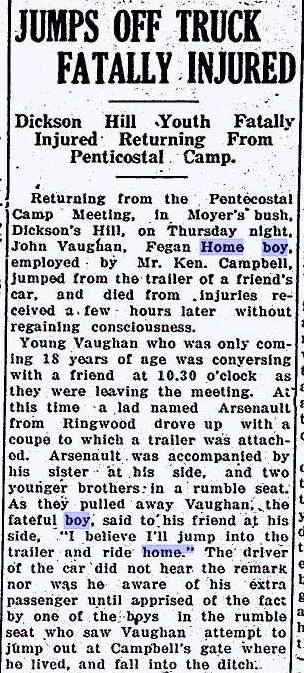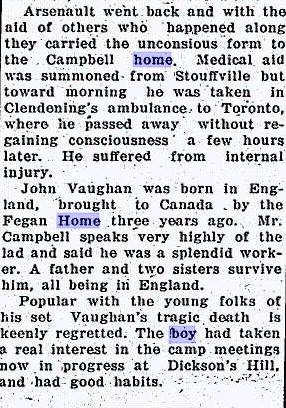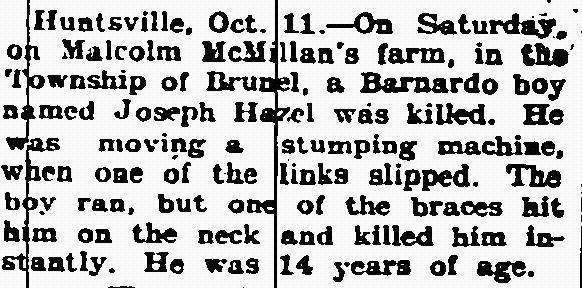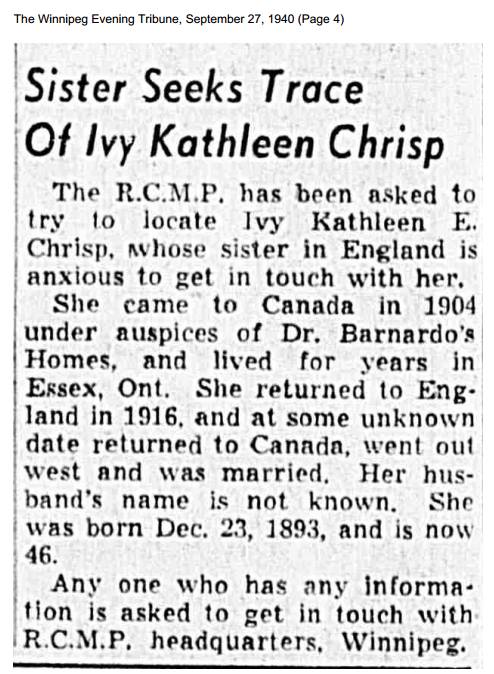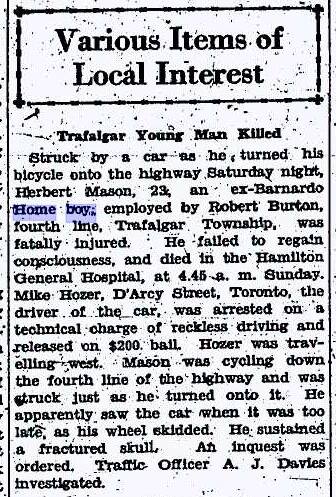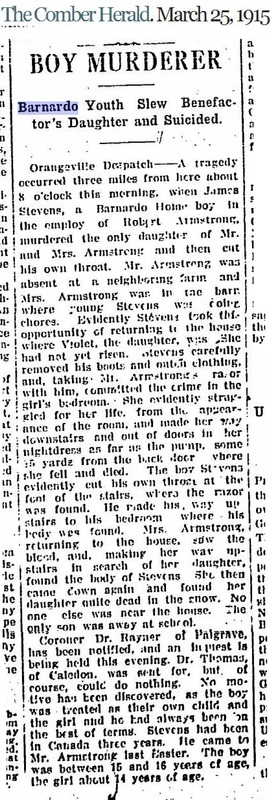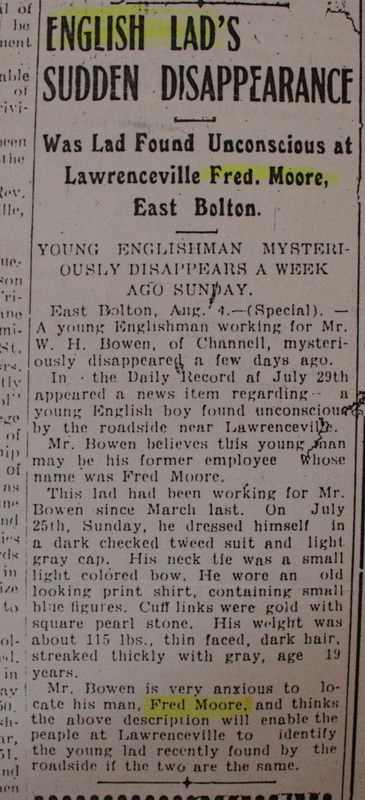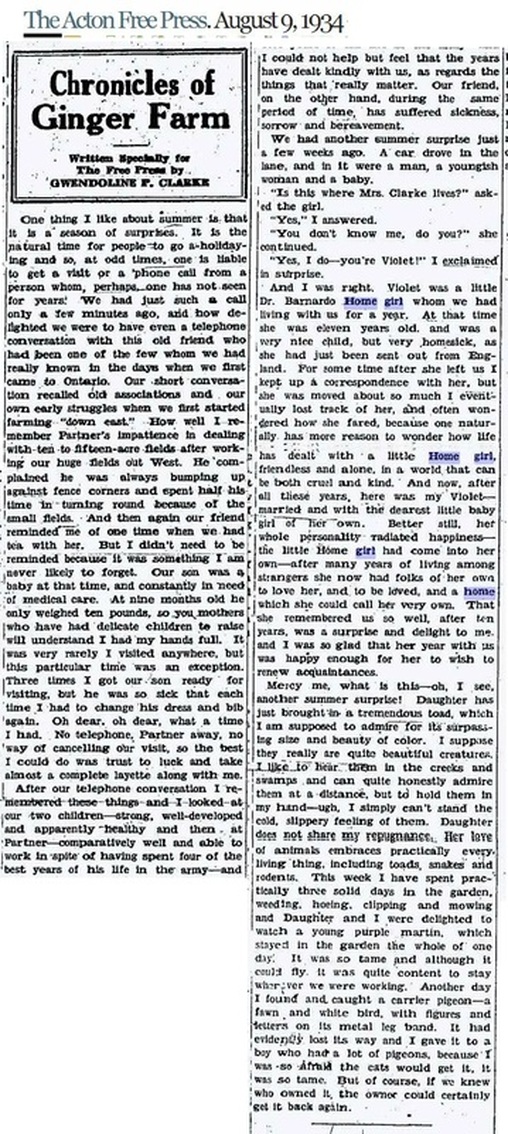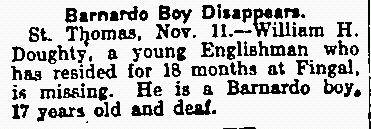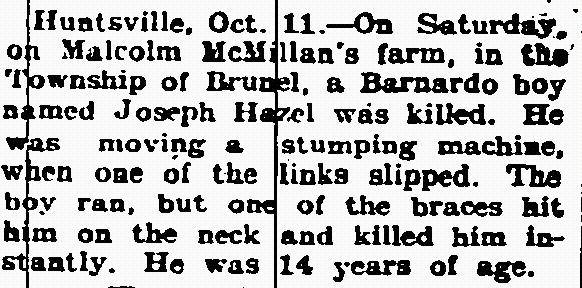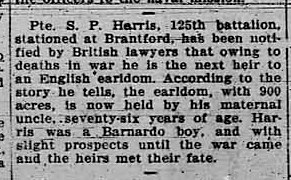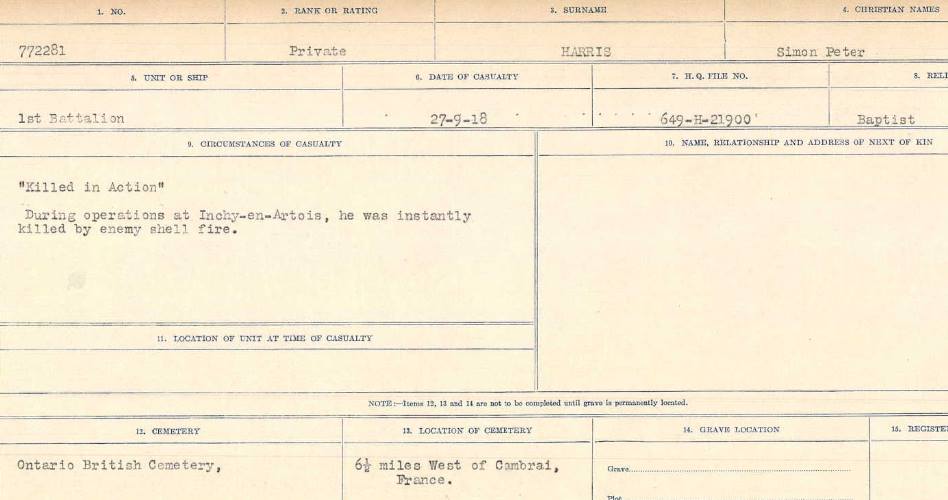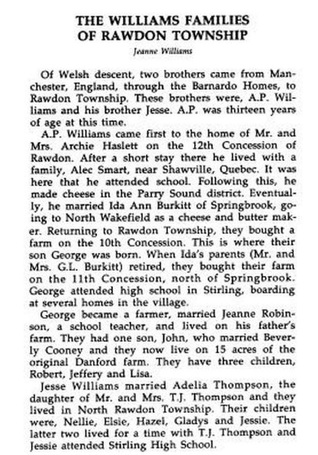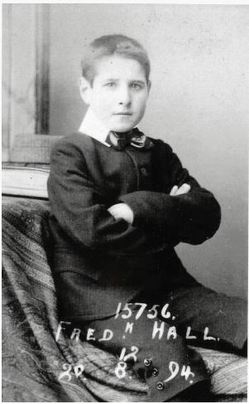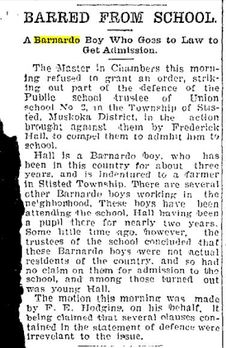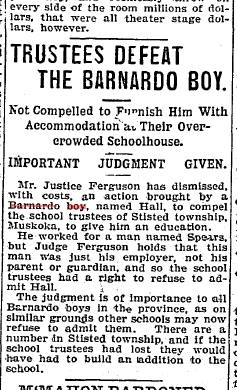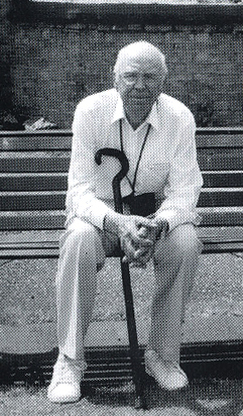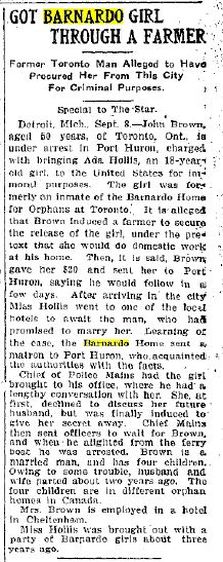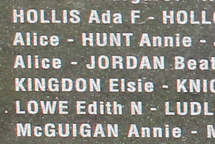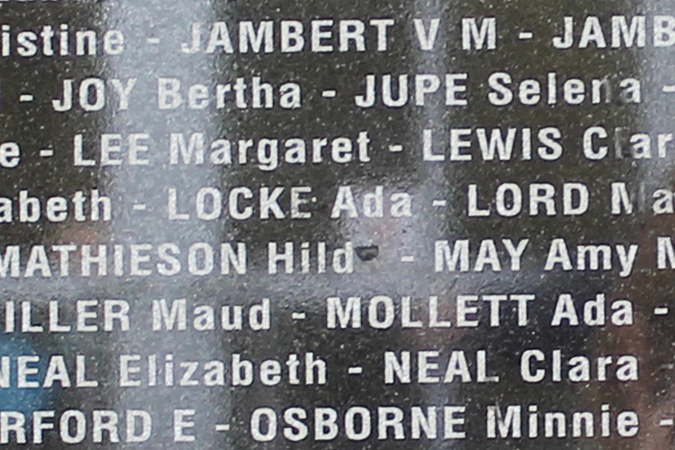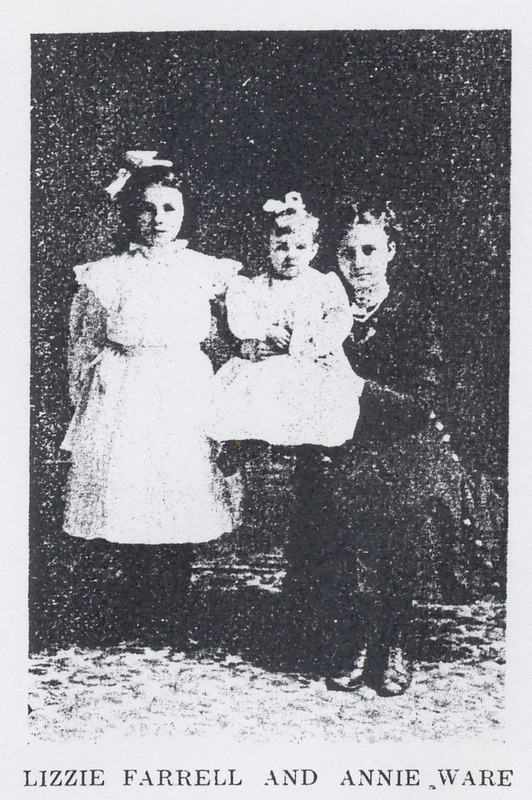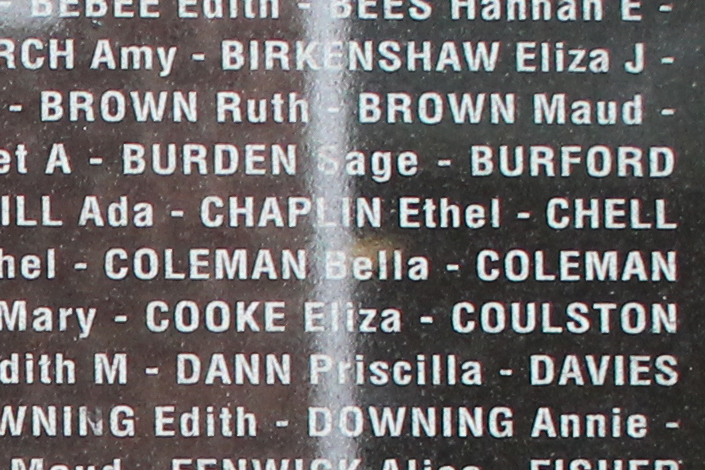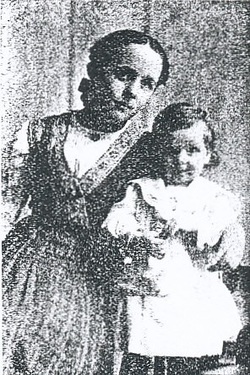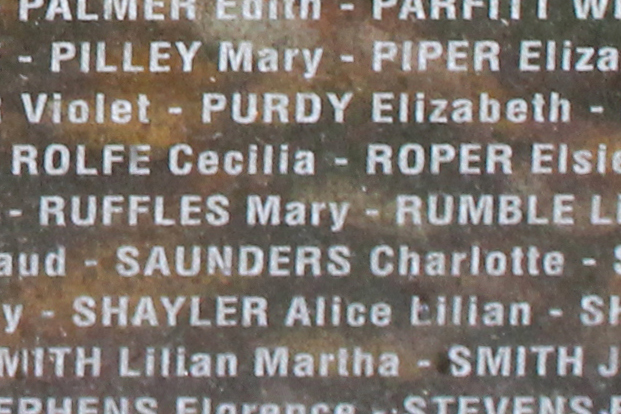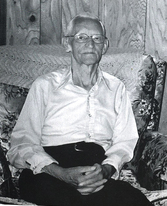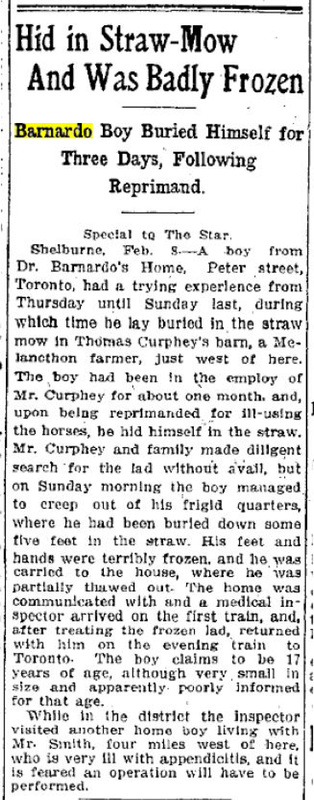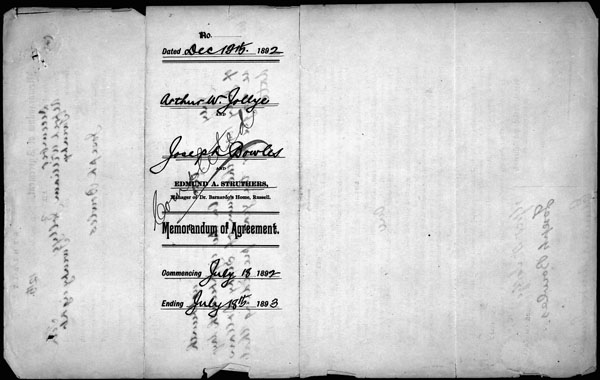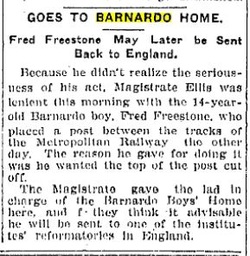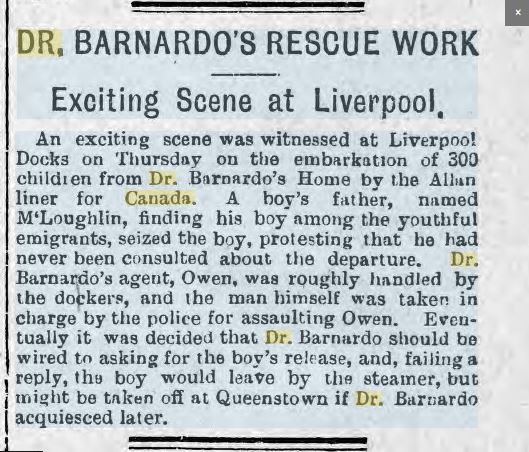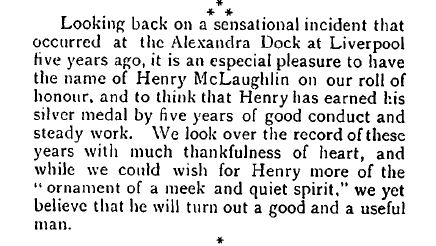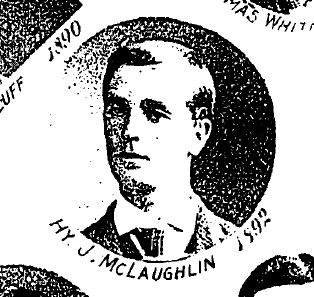|
John VaughnSurname: VAUGHAN, Given Name: John, Age: 15
Sex: M, Ship: Duchess of Richmond, Year of Arrival: 1932, Departure Port: Liverpool Departure Date: 1932-04-15, Arrival Port: Quebec ,Arrival Date: 1932-04-23, Party: Fegan Homes Destination: Toronto, Ontario, Comments: 17 boys to the Fegan Distributing Home, 295 George Street, Toronto, Herbert Beeby in charge of the party. Notes: Vol. 1, p. 97, Source: Library and Archives Canada, Reference: RG 76 C1a, Microfilm: T-14777 Type of Record: Passenger Lists |
|
Malcolm McMillan, Joseph Hazel
Robert Henry Beecher
The Waterford Star edition- Thurs. July 6, 1916 Page 1 St. Williams Man Shot Simcoe, July 2 - John Simmons, a farmer, living near St. Williams, is dead as a result of a shot fired from a rifle in the hands of Robert Henry Beecher, when the two engaged in a dispute this afternoon, and Simmons sought to take the rifle from the hands of Beecher, who is a sixteen-year-old boy, and the weapon was discharged, killing Simmons. Beecher was arrested by Constable Murphy, and remanded until july 7. He was brought to simcoe to-night. The shooting occurred about four o'clock this afternoon on a farm owned by Miss Ida Barr. Beecher and Simmons were engaged in some target practice with a .22 rifle after returning from church, and getting into a hot argument Simmons attempted to take the weapon out of the youth's hands, when it went off during the mix-up. It is understood that Miss Carr was a witness of the quarrel. Dr. Meek, of Port Rowans, will hold a Coroner's inquest. Beecher, who is a Barnardo boy, received a fairly good high school education at Port Rowan. *further mention of Beecher at the jail in the July 13th edition,page 1.) |
Herbert Mason
Robert Burton, Mike Hozer, THE TRAGIC LIFE OF ROBERT HENRY WALTER BEECHER
Robert Henry Beecher, suspended sentence Robert Henry Beecher, born in 1900, arrived in Canada from Barnardo’s in 1909. He went to live with Miss Ida Carr in Forestville, Norfolk County (Simcoe area). Over a period of several years, Miss Carr had a few Barnardo boys on her farm. She encouraged education and provided a family atmosphere for her boys. Miss Carr employed a handyman, John Simmons. Simmons took an intense dislike to Robert Beecher. It’s believed that Simmons assaulted Beecher on many occasions while the two worked together. On July 2, 1916, while two of Carr’s other boys were visiting the farm on military leave, an argument broke out between Simmons and Beecher. Simmons humiliated and threatened 16 year-old Beecher. Beecher, who had been using a shotgun for target practice, turned the gun on Simmons and killed him. Much of the community supported Beecher who was known to be an excellent student with a possible teaching career in his future. The Waterford Star published the following on July 6, 1916: John Simmons, a farmer, living near St. Williams, is dead as a result of a shot fired from a rifle in the hands of Robert Henry Beecher, when the two engaged in a dispute this afternoon, and Simmons sought to take the rifle from the hands of Beecher, who is a sixteen-year-old boy, and the weapon was discharged, killing Simmons. Beecher was arrested by Constable Murphy, and remanded until July 7. He was brought to Simcoe. The shooting occurred about four o’clock this afternoon on a farm owned by Miss Ida Carr. Beecher and Simmons were engaged in some target practice with a .22 rifle after returning from church, and getting into a hot argument, Simmons attempted to take the weapon out of the youth’s hands, when it went off during the mix-up. It is understood that Miss Carr was a witness of the quarrel. Dr. Meek, of Port Rowans, will hold a Coroner’s inquest. Beecher, who is a Barnardo boy, received a fairly good high school education at Port Rowan. At the trial, Beecher was found not guilty of murder but guilty of the lesser charge of manslaughter. The judge gave him a suspended sentence. In 1927, Robert married Emily May Ashby, a 17 year-old Barnardo girl who arrived in 1923 at age twelve. They lived in the Peterborough area. Two years later, Beecher left Canada and returned to England without his wife. He’s listed as “deported,” but the reason for this is unknown. Little is known about Beecher after he left Canada. He remarried In 1944, to Theresa Parker. The couple had at least one child. Robert Henry Beecher died in March 1980. Note: Robert’s brother, Charles William, a Barnardo boy, arrived in Canada, also in 1909, but on a separate sailing. William went to a farmer named Link in Shanty Bay. He enlisted in 1918 as a Bugler, 1st Battalion, 2nd Canadian Overseas Expeditionary Force. from Promises of home. Ivy Kathleen Chrisp -
arrived in 1904 with Dr. Barnardo's Ivy was the daughter of Dorothy Florence Chrisp (who died in 1902) and her husband Henry William H Chrisp. She was the second eldest sibling of: William Henry Chrisp 1892 – Claud Horace Chrisp 1895 – 1898 May Regina Chrisp 1897 – Cecil Ernest Chrisp 1898 – Ivy married John Joseph Roy Austin on January 2 1943 in Amherstburg, Ontario. |
Home Girl Violet
Violet was a Dr. Barnardo Home Child who once worked on Ginger Farms. She worked for Gwendoline F. Clarke
http://www.amazon.ca/Chronicles-Ginger-Farm-Canadian-1929-1962/dp/1926645022
Google Books preview - Chronicles of Ginger Farm
http://www.amazon.ca/Chronicles-Ginger-Farm-Canadian-1929-1962/dp/1926645022
Google Books preview - Chronicles of Ginger Farm
Stanley Cluse
The Essex Free Press. January 11, 1957 (referencing past events)
Surname: CLUSE Given Name: Stanley Age: 7 Sex: M Ship: Canada Year of Arrival: 1903 Departure Port: Liverpool Departure Date: 1903-03-20 Arrival Port: Halifax Arrival Date: 1903-03-28 Party: Barnardo Homes Destination: Toronto, Ontario Comments: See also Film C-4715 Source: Library and Archives Canada Reference: RG 76 C1b Microfilm: T-496 Type of Record: Passenger Lists (arrived with a brother H. G. Cluse
William H Doughty
|
Joseph Hazell
|
Simon Peter HarrisLethbridge Alberta Herald May 2, 1916.
Canadian Great War Project Died: September 27, 1918 Researched by Maureen Vollum |
Hettie D. Mills
London Woman Seeking Kin adopted 23 years ago -- records not open. IN BARNARDO HOME.
Special to the Star.
London June 8 1933
Disheartened by 23 years continuous searching for her sister, Mrs Walter Green met failure in the renewal of her
quest in Toronto yesterday. Returning to London Mrs Green laid fresh plans for a hunt based on meagre information obtained through Barnardo homes, now holding records taken over from Annie Macpherson home, formerly operated in Stratford.
Back in 1910 when Hettie D. Mills was 8 years old, she was adopted from the Macpherson home by a Mrs Stephen Wiles of Toronto. Her sister, now Mrs Green, and a brother David, had been separately adopted at about the same time and no contact had been maintained among the children. In 1928, after a long and persistent search, Mrs Green traced David. Ceaselessly since the brother, who is now in London employed as a factory foreman, and Mrs Green have conducted their hunt. Yesterday in search of old city directories in Toronto Mrs Green found that from 1910 till 1913 a Stephen Wiles lived at 105 and later 153 Harbord St. From 1914 to 1918 the same name waswas listed at 42 Ascot St. From then forward the name is out of the Toronto directory. A resident in the district told Mrs Green that Wiles had been a salesman for the T. Eaton Co. He believed Wiles died in 1919.
Thus the hunt for Hattie Mills, now in her thirty-first year, continues. "I have been asked by officials of the home and by lawyers what I want my sister for," Mrs Green told the Star. "What would anyone want to see her sister for? We have been separated all these years. For the last five years I never ceased searching. I have employed detectives who told me the Barnardo home is not at liberty to give any information."
Special to the Star.
London June 8 1933
Disheartened by 23 years continuous searching for her sister, Mrs Walter Green met failure in the renewal of her
quest in Toronto yesterday. Returning to London Mrs Green laid fresh plans for a hunt based on meagre information obtained through Barnardo homes, now holding records taken over from Annie Macpherson home, formerly operated in Stratford.
Back in 1910 when Hettie D. Mills was 8 years old, she was adopted from the Macpherson home by a Mrs Stephen Wiles of Toronto. Her sister, now Mrs Green, and a brother David, had been separately adopted at about the same time and no contact had been maintained among the children. In 1928, after a long and persistent search, Mrs Green traced David. Ceaselessly since the brother, who is now in London employed as a factory foreman, and Mrs Green have conducted their hunt. Yesterday in search of old city directories in Toronto Mrs Green found that from 1910 till 1913 a Stephen Wiles lived at 105 and later 153 Harbord St. From 1914 to 1918 the same name waswas listed at 42 Ascot St. From then forward the name is out of the Toronto directory. A resident in the district told Mrs Green that Wiles had been a salesman for the T. Eaton Co. He believed Wiles died in 1919.
Thus the hunt for Hattie Mills, now in her thirty-first year, continues. "I have been asked by officials of the home and by lawyers what I want my sister for," Mrs Green told the Star. "What would anyone want to see her sister for? We have been separated all these years. For the last five years I never ceased searching. I have employed detectives who told me the Barnardo home is not at liberty to give any information."
Alexander Alexander McKean
Dr. Barnardo was at the ship to bid us farewell when my brother David and I sailed for Canada in 1905. David was nine and I was eleven. I remember that we were in the back of the ship, probably third class. The voyage lasted between two to three weeks. We were stopped for at least one day by icebergs.
On our arrival in Canada we went by train to Winnipeg and spent about two weeks together in the home. There we were told we would be separated, I remember we crawled into bed together that last night an cried with arms around each other until we went to sleep.
I was sent to a farmer near Miniota, Manitoba. One day about three years later my boss took me to a country fair. I was wandering around and I saw this boy who looked familiar. I walked up to him and said "I think you're my brother." When my boss came to say it was time to go home, I said "I've found my brother." So he gave us two bits and told us to go and buy something with it. We bought some bananas and sat on the railway ties and talked and talked. My brother lived at Beulah, a village about nine miles from my place.
My brother David was awarded a medal from the Barnardo Home for 'Good Conduct and Length of Service.' I did not recive one. I was moved from my first farm, although I did not tell my home representative of my plight. The hired man wrote someone about it --- probably to the home --- and I was moved to another place where I stayed until my brother an I went overseas in 1914.
Alexander, Alexander, McKean (1893-1975)
Miniota, Manitoba
http://familytreemaker.genealogy.com/users/m/c/k/Mark-A-Mckean/GENE1-0002.html
On our arrival in Canada we went by train to Winnipeg and spent about two weeks together in the home. There we were told we would be separated, I remember we crawled into bed together that last night an cried with arms around each other until we went to sleep.
I was sent to a farmer near Miniota, Manitoba. One day about three years later my boss took me to a country fair. I was wandering around and I saw this boy who looked familiar. I walked up to him and said "I think you're my brother." When my boss came to say it was time to go home, I said "I've found my brother." So he gave us two bits and told us to go and buy something with it. We bought some bananas and sat on the railway ties and talked and talked. My brother lived at Beulah, a village about nine miles from my place.
My brother David was awarded a medal from the Barnardo Home for 'Good Conduct and Length of Service.' I did not recive one. I was moved from my first farm, although I did not tell my home representative of my plight. The hired man wrote someone about it --- probably to the home --- and I was moved to another place where I stayed until my brother an I went overseas in 1914.
Alexander, Alexander, McKean (1893-1975)
Miniota, Manitoba
http://familytreemaker.genealogy.com/users/m/c/k/Mark-A-Mckean/GENE1-0002.html
Thomas Patrick Downes
Grandfather's good conduct medal now a proud family reminder of past
In 1901, my grandfather Thomas Patrick Downes entered Dr. Barnardo's School of Foundlings in London, after both his parents died of consumption and his uncle could no longer afford to keep him. The following year, 1902, 11-year-old Thomas was one of 684 boys and 369 girls sent to Canada to become indentured farmhelpers and house-servants. My grandfather disembarked in Boston and was sent west by train to a small farming community, where he remained until adulthood.
BY VANCOUVER SUN DECEMBER 30, 2009
In 1901, my grandfather Thomas Patrick Downes entered Dr. Barnardo's School of Foundlings in London, after both his parents died of consumption and his uncle could no longer afford to keep him. The following year, 1902, 11-year-old Thomas was one of 684 boys and 369 girls sent to Canada to become indentured farmhelpers and house-servants. My grandfather disembarked in Boston and was sent west by train to a small farming community, where he remained until adulthood.
Many of the "homeboys" and girls were very badly treated, but the family my grandfather went to live with loved him and truly treated him as one of the family. While in their service, he was awarded a silver medal from Dr. Barnardo's for good conduct and length of service. He kept this medal with one he'd received for punctual attendance for the next 50-plus years until he decided to pass them on.
I can't believe my grandfather gave me both these medals when I was a very young girl, about the same age as he was when he came to Canada. I lost them once while playing with them outdoors, but found them again days later in the tall grass. Now, of course, I keep them in a safety deposit box.
We were recently able to obtain all my grandfather's records from Dr. Barnardo's and we were thrilled to find the picture taken of him on admission to the orphanage. We are so thankful that life truly did become better for that lost-looking little boy who became my greatly beloved Grampa ... and that's why I cherish these medals he entrusted to me so many years ago.
In 1901, my grandfather Thomas Patrick Downes entered Dr. Barnardo's School of Foundlings in London, after both his parents died of consumption and his uncle could no longer afford to keep him. The following year, 1902, 11-year-old Thomas was one of 684 boys and 369 girls sent to Canada to become indentured farmhelpers and house-servants. My grandfather disembarked in Boston and was sent west by train to a small farming community, where he remained until adulthood.
BY VANCOUVER SUN DECEMBER 30, 2009
In 1901, my grandfather Thomas Patrick Downes entered Dr. Barnardo's School of Foundlings in London, after both his parents died of consumption and his uncle could no longer afford to keep him. The following year, 1902, 11-year-old Thomas was one of 684 boys and 369 girls sent to Canada to become indentured farmhelpers and house-servants. My grandfather disembarked in Boston and was sent west by train to a small farming community, where he remained until adulthood.
Many of the "homeboys" and girls were very badly treated, but the family my grandfather went to live with loved him and truly treated him as one of the family. While in their service, he was awarded a silver medal from Dr. Barnardo's for good conduct and length of service. He kept this medal with one he'd received for punctual attendance for the next 50-plus years until he decided to pass them on.
I can't believe my grandfather gave me both these medals when I was a very young girl, about the same age as he was when he came to Canada. I lost them once while playing with them outdoors, but found them again days later in the tall grass. Now, of course, I keep them in a safety deposit box.
We were recently able to obtain all my grandfather's records from Dr. Barnardo's and we were thrilled to find the picture taken of him on admission to the orphanage. We are so thankful that life truly did become better for that lost-looking little boy who became my greatly beloved Grampa ... and that's why I cherish these medals he entrusted to me so many years ago.
Edith Hawkins, Herbert Williams
WILLIAMS ACQUITTED OF YOUNG GIRL'S DEATH
Globe and Mail Aug 14, 1913
But Jury Strongly Condemned Careless Handling of Firearms Brockville, Aug. 13.--Herbert Williams, seventeen years old, who has been held in connection with the death of Edith Hawkins, nine years, was liberated from custody last night in Westport at the conclusion of an inquest conducted by Dr. Berry of that village. It was conclusively proven that the shooting was accidental, but the jury strongly criticized the boy and all others who handle firearms carelessly. It was a case of cleaning a gun and pulling the trigger not knowing that it contained a cartridge.
Williams and the deceased child were received from the Barnardo Home, and Mr. C.H. Black, Toronto, representing the home, gave character evidence in favor of Williams. The boy wept bitterly throughout the proceedings. They were adopted by Mr. and Mrs. David Leacock, farmers, who gave evidence in favor of Williams.
Williams and the deceased child were received from the Barnardo Home, and Mr. C.H. Black, Toronto, representing the home, gave character evidence in favor of Williams. The boy wept bitterly throughout the proceedings. They were adopted by Mr. and Mrs. David Leacock, farmers, who gave evidence in favor of Williams.
Peter Graham 1931
Quarrier immigrant
Where money grew on trees (Home children). by Christine Hamelin. Queen's Quarterly Fall 1997 v104 i3 p436-49 COPYRIGHT 1997 Queen's Quarterly contains the following: "[Peter Graham, a 1931 Quarrier immigrant age 17] was also separated from other Quarriers emigrants. His best friend from the Home lived only five miles away, but he did not know this until thirty years later. Often, friends and siblings were not informed of each other's locations in Canada. Two brothers met up by chance at a country fair. In another story, a Quarriers boy who had emigrated to Canada was joyfully reunited with his brother in a trench during the First World War, only to see him killed the following morning. "There are some stories, now legendary, of mistreatment. One boy whose shoes had grown too small would run barefoot through the snow in giant leaps from the house to the barn every morning, and then stand in a fresh cow patty until his feet grew warm."
Harry Brown Oct 8, 1913
CHARGE OF ARSON LAID AGAINST BARNARDO BOY
Strong Pleas Made in his Behalf and Judge Defers Sentence. Orangeville, Oct. 7.--His Honor Judge Walter G. Fisher, the newly-appointed Judge of Dufferin county, held his first Criminal Court here today, when Harry Brown, a Barnardo boy, who has been in jail here since shortly after the commission of the offence, was brought before his Honor charged with arson, he having fired the house of his employer, ex-Reeve Hilliard anderson of Mono, on the night of July 26, during the owner's absence. The residence and contents were totally destroyed, and the loss in excess of insurance was some $1,500. Brown was suspected, and shortly after the fire was arrested and made a written confession to the authorities. To-day the prisoner pleaded guilty, and elected to be tried by Judge Fisher.
Rev. G.W. Tebbs, rector of St. Mark's Anglican Church, interested himself in the accused, and at his instigation the Barnardo authorites retained Mr. C.R. McKeown, K.C., M.P.P., to urge for the clemency of the court.
Mr. McKeown read several letters from former employers of Brown, who is about eighteen years of age. All the writers spoke in the highest terms of the youth who was charged with so serious a crime, and offered to take him back into their employ, and hoped he would get a light sentence. Mr McKeown spoke of the average goodness of the Barnardo boys and the great work which had been accomplished, and deprecated sending the accused to associate with hardened criminals.
A charge of lunacy had also been laid, and the boy had been examined by two medical experts, one of whom concluded he was weak-minded and imbecile, but could distinguish between right and wrong.
Crown Attorney McKay said he did not wish to say anything which might increase the penalty the court might see fit to inflict. After setting fire to the house, the accused had admitted shooting holes through his own coat from the inside and trying to cast the blame on others. The Crown Attorney regretted there was no midway instition for the care of such persons, as the prisoner appeared to be between the asylum and the Central Prison.
Judge Fisher spoke kindly but seriously to the accused, saying the enormity of the offence could not be overlooked. He would carefully consider the matter and impose sentence on Friday. The case has excited considerable interest in this county, where many Barnardo boys are employed by farmers. As a rule they give very good satisfaction.
NOTE: Rev. Tebbs came to Canada to run the Smyly Home in Hespeler. He gave that up to become a minister.
Rev. G.W. Tebbs, rector of St. Mark's Anglican Church, interested himself in the accused, and at his instigation the Barnardo authorites retained Mr. C.R. McKeown, K.C., M.P.P., to urge for the clemency of the court.
Mr. McKeown read several letters from former employers of Brown, who is about eighteen years of age. All the writers spoke in the highest terms of the youth who was charged with so serious a crime, and offered to take him back into their employ, and hoped he would get a light sentence. Mr McKeown spoke of the average goodness of the Barnardo boys and the great work which had been accomplished, and deprecated sending the accused to associate with hardened criminals.
A charge of lunacy had also been laid, and the boy had been examined by two medical experts, one of whom concluded he was weak-minded and imbecile, but could distinguish between right and wrong.
Crown Attorney McKay said he did not wish to say anything which might increase the penalty the court might see fit to inflict. After setting fire to the house, the accused had admitted shooting holes through his own coat from the inside and trying to cast the blame on others. The Crown Attorney regretted there was no midway instition for the care of such persons, as the prisoner appeared to be between the asylum and the Central Prison.
Judge Fisher spoke kindly but seriously to the accused, saying the enormity of the offence could not be overlooked. He would carefully consider the matter and impose sentence on Friday. The case has excited considerable interest in this county, where many Barnardo boys are employed by farmers. As a rule they give very good satisfaction.
NOTE: Rev. Tebbs came to Canada to run the Smyly Home in Hespeler. He gave that up to become a minister.
The Gough Women
CSILLAG [email protected]_county.toronto.globe_and_mail 2007-07-02 published
She was the First Anglican woman elected a parish warden in Toronto. Raised in 11 foster homes, she became a teacher and counsellor who championed the rights of aboriginal people, immigrants, gays, the poor and the marginalized long before it was trendy
By Ron CSILLAG, Special▼ to The Globe and Mail, Page S10
Toronto -- You'd think being shunted from one foster home to another would make a person hard. Helen GOUGH -- born illegitimate at a time when that was a stigma -- spent her childhood in no fewer than 11 foster homes, and emerged a gentle but tenacious advocate with an outsized social conscience that was fired by her mentor, Jesus. "Whatever I did, I did it as a Christian," she wrote in the preface to her unpublished memoirs. "I was a Jesus freak. I wanted to lead that kind of life."
In doing so, Ms. GOUGH "turned the Gospels upside down [by] turning those who were down, up," eulogized Rev. Sara BOYLES, priest at Ms. GOUGH's beloved Holy Trinity Church in downtown Toronto. "Helen turned the world upside down."
She did that, against all odds, by excelling in the so-called helping professions: Teaching, counselling and activism for aboriginal people, immigrants, gays, the poor and the marginalized. She stood up for their rights long before it was trendy, often forsaking her own fragile psyche.
Far from being a household name, except perhaps within the Anglican Church's more progressive elements in Toronto, Ms. GOUGH would not have minded being labelled ordinary, though she was far from it. "It's ordinary people, ordinary women, who have done much of what it took to make this nation what it is," she stated not long ago. "Ordinary people with extraordinary courage. Whatever else I am, I'm a Canadian. I'm a Canadian woman."
She was the first woman elected a parish warden in the Anglican Church of Canada's Toronto diocese, in 1971.
Her mother, also named Helen GOUGH, play a pivotal role in her fatherless and husbandless life. The elder Ms. GOUGH, who died in 1981, had been a Barnardo child, one of some 30,000 sick, destitute or orphaned British children shipped to the colonies as "seedling citizens of the British Empire" by English philanthropist Thomas Barnardo to work on farms or as domestics. (Between 600 and 1,000 children were sent to Canada from the late 1800s to 1915.)
Helen senior, with still-fresh memories of time spent in an actual English poorhouse, arrived in Southern Ontario in 1912 as a 10-year-old, together with her younger brother, Arthur. She toiled as a servant at seven different places until she turned 18, surviving on the cheapest foods and not once being allowed to use an indoor toilet.
On her own in Toronto, she found work as a clerk at the Hospital for Sick Children, and soon fell in with a crowd that included a handsome, suave clothing salesman from Stratford. When she became pregnant, he denied all knowledge of her, as advised by his uncle, a judge. It wasn't until the younger Ms. GOUGH was in her late 40s that she discovered her father's identity; he had become a fat drunk and died of a coronary when he was 60.
Too poor to raise her daughter, the elder Ms. GOUGH, by this time a live-in domestic, appealed to Catholic Children's Aid. (The child's father was Catholic.) But if the agency took the child in, she would be raised in an orphanage as a Roman Catholic. Her mother declined. "It must have taken tremendous courage for a woman to do that in 1930, and she was one of many who simply refused," her daughter later wrote.
Instead, her mother turned to the Children's Aid Society, which transferred the sickly baby to a woman whose sole task was to nurse sick infants back to health. Then came long years of foster care at nearly a dozen places, during which mother and daughter saw each other only intermittently. By the age of eight, young Helen had already attended Baptist, United and Roman Catholic churches, but made up her mind that the Anglicans were for her. She finally went to live with her mother when she was 15.
Ms. GOUGH's first taste of overt racism came while she worked as a teenage waitress one summer at the Pearson Hotel on Centre Island. As she recalled, a short, self-important Englishman working in the kitchen informed a Chinese dishwasher: "I'm not taking any orders from a bloody Chink!" The Chinese man, a foot taller, brought the dish he was holding down on the man's skull. The plate shattered, and the blood coursed down the small man's head. Both were fired, and the incident stayed with her forever.
She was 19 when she befriended Gerry O'DONOGHUE of Toronto (later Gerry RANSOM,) whose family adopted Ms. GOUGH as one of their own, and whose daughter Beverley was Ms. GOUGH's goddaughter.
The same year, Ms. GOUGH graduated from Toronto Teachers' College and went to teach near Port Credit, Ontario That was followed by four years of teaching status Indians and Métis at an "Indian Day School" in Moose Lake, southeast of The Pas, Manitoba
Life was primitive and harsh, but for Ms. GOUGH, it was happily reminiscent of the Girl Guides camps she'd attended as a child. The three teachers took turns doing the three main chores: one week each on cooking, cleanup and "wood and water."
It was here that she became smitten with the shy aboriginal children, and impressed with their determination to learn English. (There is no mention in Ms. GOUGH's memoirs of church-run residential schools, where native children underwent horrific abuses that led to multimillion-dollar legal payouts decades later.) After teaching catechism and assisting with church services, she returned to Toronto to deepen her spirituality by studying at the Anglican Women's Training College. One summer, she took a job with the federal government's Indian Affairs department teaching at an Ojibwa-Cree settlement in Bearskin Lake, Ontario
In 1960, she began as an "Indian liaison worker" in the Toronto diocese, helping aboriginals access "white" social service agencies. It was half-time initially, "since no one really believed there were Indians in Toronto," she would recall. She was a pioneer of the first native centre in Toronto, and proudly outed a co-worker who had referred to Ms. GOUGH's client as "dirty and drunken&hellip you know, a typical Indian."
The man who had made the remark "was not happy about being exposed, but it was a great moment of insight for me," she remembered. "It's important to speak truth to power when we are in positions to do so. If we don't, who will?"
Around this time, Ms. GOUGH noticed that she was prone to periodic bouts of depression, preceded by highs that dropped to debilitating lows, and an inability to control either. The condition led her to years of psychotherapy and such treatments as psychodrama, bioenergetics and Arthur Janov's primal therapy, during which she began to face the pain of separation she'd experienced as a child.
She went into social service work for the diocese, mainly on housing conditions in Toronto, before returning to school at 35 to earn a B.A. at York University. She confessed that it was the worst experience of her adult life. With a D average, "I was so ashamed, I didn't go to my graduation or tell my mother about it until much later." Despite that, she returned to York a decade later to earn a master's degree in English, with honours, and an essay prize.
Meantime, there was a flurry of action in Toronto: In 1968, she was one of the original activists to develop Alexandra Park Co-op, today a 410-unit housing project in downtown Toronto (she worked alongside June Rowlands, who went on to become mayor of Toronto). She then worked for the Young Women's Christian Association, finding rooms for Caribbean domestics, before taking a job for 17 years with the Toronto Board of Education, working extensively with immigrant parents. Her involvement with the Riverdale Intergenerational Project brought seniors into schools as volunteers.
She embraced gay rights through what she called a particularly Anglican resolution: "All may, none must and some ought." Tall, gangly and sometimes physically awkward, she denied being a lesbian, "although I feel more comfortable with women than men. If you grow up in a series of homes, you don't learn to establish primary relationships. There were boys I really liked but I saw myself as plain. I was a wallflower at dances and very bookish. I made good secondary relationships, but primary ones [were] much more difficult."
In retirement, she seemed to accelerate, taking up travel, river rafting, voice lessons and photography. She produced pictures that testified to an almost child-like wonderment about the natural world.
She saw her mission through a simple lens: If she was going to do anything as a Christian, it was to respond to society's dispossessed. "I was not there to hold office," she reasoned, "but to meet people on the ground."
Helen Noreen Honora GOUGH was born in Toronto on November 21, 1930, and died there of cancer on June 1, 2007. She was 76. According to her wishes, only men washed her body prior to burial. She leaves her adoptive family, the Ransoms, and many Friends and admirers.
She was the First Anglican woman elected a parish warden in Toronto. Raised in 11 foster homes, she became a teacher and counsellor who championed the rights of aboriginal people, immigrants, gays, the poor and the marginalized long before it was trendy
By Ron CSILLAG, Special▼ to The Globe and Mail, Page S10
Toronto -- You'd think being shunted from one foster home to another would make a person hard. Helen GOUGH -- born illegitimate at a time when that was a stigma -- spent her childhood in no fewer than 11 foster homes, and emerged a gentle but tenacious advocate with an outsized social conscience that was fired by her mentor, Jesus. "Whatever I did, I did it as a Christian," she wrote in the preface to her unpublished memoirs. "I was a Jesus freak. I wanted to lead that kind of life."
In doing so, Ms. GOUGH "turned the Gospels upside down [by] turning those who were down, up," eulogized Rev. Sara BOYLES, priest at Ms. GOUGH's beloved Holy Trinity Church in downtown Toronto. "Helen turned the world upside down."
She did that, against all odds, by excelling in the so-called helping professions: Teaching, counselling and activism for aboriginal people, immigrants, gays, the poor and the marginalized. She stood up for their rights long before it was trendy, often forsaking her own fragile psyche.
Far from being a household name, except perhaps within the Anglican Church's more progressive elements in Toronto, Ms. GOUGH would not have minded being labelled ordinary, though she was far from it. "It's ordinary people, ordinary women, who have done much of what it took to make this nation what it is," she stated not long ago. "Ordinary people with extraordinary courage. Whatever else I am, I'm a Canadian. I'm a Canadian woman."
She was the first woman elected a parish warden in the Anglican Church of Canada's Toronto diocese, in 1971.
Her mother, also named Helen GOUGH, play a pivotal role in her fatherless and husbandless life. The elder Ms. GOUGH, who died in 1981, had been a Barnardo child, one of some 30,000 sick, destitute or orphaned British children shipped to the colonies as "seedling citizens of the British Empire" by English philanthropist Thomas Barnardo to work on farms or as domestics. (Between 600 and 1,000 children were sent to Canada from the late 1800s to 1915.)
Helen senior, with still-fresh memories of time spent in an actual English poorhouse, arrived in Southern Ontario in 1912 as a 10-year-old, together with her younger brother, Arthur. She toiled as a servant at seven different places until she turned 18, surviving on the cheapest foods and not once being allowed to use an indoor toilet.
On her own in Toronto, she found work as a clerk at the Hospital for Sick Children, and soon fell in with a crowd that included a handsome, suave clothing salesman from Stratford. When she became pregnant, he denied all knowledge of her, as advised by his uncle, a judge. It wasn't until the younger Ms. GOUGH was in her late 40s that she discovered her father's identity; he had become a fat drunk and died of a coronary when he was 60.
Too poor to raise her daughter, the elder Ms. GOUGH, by this time a live-in domestic, appealed to Catholic Children's Aid. (The child's father was Catholic.) But if the agency took the child in, she would be raised in an orphanage as a Roman Catholic. Her mother declined. "It must have taken tremendous courage for a woman to do that in 1930, and she was one of many who simply refused," her daughter later wrote.
Instead, her mother turned to the Children's Aid Society, which transferred the sickly baby to a woman whose sole task was to nurse sick infants back to health. Then came long years of foster care at nearly a dozen places, during which mother and daughter saw each other only intermittently. By the age of eight, young Helen had already attended Baptist, United and Roman Catholic churches, but made up her mind that the Anglicans were for her. She finally went to live with her mother when she was 15.
Ms. GOUGH's first taste of overt racism came while she worked as a teenage waitress one summer at the Pearson Hotel on Centre Island. As she recalled, a short, self-important Englishman working in the kitchen informed a Chinese dishwasher: "I'm not taking any orders from a bloody Chink!" The Chinese man, a foot taller, brought the dish he was holding down on the man's skull. The plate shattered, and the blood coursed down the small man's head. Both were fired, and the incident stayed with her forever.
She was 19 when she befriended Gerry O'DONOGHUE of Toronto (later Gerry RANSOM,) whose family adopted Ms. GOUGH as one of their own, and whose daughter Beverley was Ms. GOUGH's goddaughter.
The same year, Ms. GOUGH graduated from Toronto Teachers' College and went to teach near Port Credit, Ontario That was followed by four years of teaching status Indians and Métis at an "Indian Day School" in Moose Lake, southeast of The Pas, Manitoba
Life was primitive and harsh, but for Ms. GOUGH, it was happily reminiscent of the Girl Guides camps she'd attended as a child. The three teachers took turns doing the three main chores: one week each on cooking, cleanup and "wood and water."
It was here that she became smitten with the shy aboriginal children, and impressed with their determination to learn English. (There is no mention in Ms. GOUGH's memoirs of church-run residential schools, where native children underwent horrific abuses that led to multimillion-dollar legal payouts decades later.) After teaching catechism and assisting with church services, she returned to Toronto to deepen her spirituality by studying at the Anglican Women's Training College. One summer, she took a job with the federal government's Indian Affairs department teaching at an Ojibwa-Cree settlement in Bearskin Lake, Ontario
In 1960, she began as an "Indian liaison worker" in the Toronto diocese, helping aboriginals access "white" social service agencies. It was half-time initially, "since no one really believed there were Indians in Toronto," she would recall. She was a pioneer of the first native centre in Toronto, and proudly outed a co-worker who had referred to Ms. GOUGH's client as "dirty and drunken&hellip you know, a typical Indian."
The man who had made the remark "was not happy about being exposed, but it was a great moment of insight for me," she remembered. "It's important to speak truth to power when we are in positions to do so. If we don't, who will?"
Around this time, Ms. GOUGH noticed that she was prone to periodic bouts of depression, preceded by highs that dropped to debilitating lows, and an inability to control either. The condition led her to years of psychotherapy and such treatments as psychodrama, bioenergetics and Arthur Janov's primal therapy, during which she began to face the pain of separation she'd experienced as a child.
She went into social service work for the diocese, mainly on housing conditions in Toronto, before returning to school at 35 to earn a B.A. at York University. She confessed that it was the worst experience of her adult life. With a D average, "I was so ashamed, I didn't go to my graduation or tell my mother about it until much later." Despite that, she returned to York a decade later to earn a master's degree in English, with honours, and an essay prize.
Meantime, there was a flurry of action in Toronto: In 1968, she was one of the original activists to develop Alexandra Park Co-op, today a 410-unit housing project in downtown Toronto (she worked alongside June Rowlands, who went on to become mayor of Toronto). She then worked for the Young Women's Christian Association, finding rooms for Caribbean domestics, before taking a job for 17 years with the Toronto Board of Education, working extensively with immigrant parents. Her involvement with the Riverdale Intergenerational Project brought seniors into schools as volunteers.
She embraced gay rights through what she called a particularly Anglican resolution: "All may, none must and some ought." Tall, gangly and sometimes physically awkward, she denied being a lesbian, "although I feel more comfortable with women than men. If you grow up in a series of homes, you don't learn to establish primary relationships. There were boys I really liked but I saw myself as plain. I was a wallflower at dances and very bookish. I made good secondary relationships, but primary ones [were] much more difficult."
In retirement, she seemed to accelerate, taking up travel, river rafting, voice lessons and photography. She produced pictures that testified to an almost child-like wonderment about the natural world.
She saw her mission through a simple lens: If she was going to do anything as a Christian, it was to respond to society's dispossessed. "I was not there to hold office," she reasoned, "but to meet people on the ground."
Helen Noreen Honora GOUGH was born in Toronto on November 21, 1930, and died there of cancer on June 1, 2007. She was 76. According to her wishes, only men washed her body prior to burial. She leaves her adoptive family, the Ransoms, and many Friends and admirers.
Fred Morris
Barnardo's
Private Fred Morris, sent to Canada as a boy of nine, "sort and scrawny", laboured on a farm, went to war at 20, returned to Canada wounded, married, adopted his wife's 2 children, had six more of his own ♥
Pte. Frederick Morris, 52nd Battalion (Tyler Labonté)
Not all the of the soldiers represented by our students lost their lives in the First World War. But none returned to Canada unscathed.
Fred Morris was 20 when he signed up in April 1916. He had known little but hard times in his first two decades. Born in Coventry, England in 1896, he suffered a disfiguring accident when he was just three years old. Military records detail the bad burn scars under and across his chin.
In 1905, the nine year old boy was packed up and sent across the ocean to Canada as one of Dr, Barnardo's "home children," British orphans or unwanted urchins who were distributed among farm families in Canada. The scheme was philanthropic in spirit, but in practice, the children often went to families who treated them as little better than slave labour.
Ten years later, Fred struck out on his own by enlisting in the Canadian army at Haileybury in northeastern Ontario (present day Temiskaming Shores).
Short and scrawny, he was sent to France with the 52nd Battalion, the Lake Superior Regiment, in the spring of 1918. He spent less than four months in the field when fate intervened. Shrapnel badly damaged both his legs, leaving him invalided for the next year, and disabled for life.
Remarkably, things seem to have gotten better for Fred after he was discharged. He found met and married Ellen Cuthbertson Grills, adopted her two children, and had six more, including the boy who would grow up to be Tyler Labonté's grandfather. (Tyler authoured this piece)
website here:
http://www.canada.com/story_print.html?id=a2997b0d-63dc-4ccd-8790-389c760daab5&sponsor
Pte. Frederick Morris, 52nd Battalion (Tyler Labonté)
Not all the of the soldiers represented by our students lost their lives in the First World War. But none returned to Canada unscathed.
Fred Morris was 20 when he signed up in April 1916. He had known little but hard times in his first two decades. Born in Coventry, England in 1896, he suffered a disfiguring accident when he was just three years old. Military records detail the bad burn scars under and across his chin.
In 1905, the nine year old boy was packed up and sent across the ocean to Canada as one of Dr, Barnardo's "home children," British orphans or unwanted urchins who were distributed among farm families in Canada. The scheme was philanthropic in spirit, but in practice, the children often went to families who treated them as little better than slave labour.
Ten years later, Fred struck out on his own by enlisting in the Canadian army at Haileybury in northeastern Ontario (present day Temiskaming Shores).
Short and scrawny, he was sent to France with the 52nd Battalion, the Lake Superior Regiment, in the spring of 1918. He spent less than four months in the field when fate intervened. Shrapnel badly damaged both his legs, leaving him invalided for the next year, and disabled for life.
Remarkably, things seem to have gotten better for Fred after he was discharged. He found met and married Ellen Cuthbertson Grills, adopted her two children, and had six more, including the boy who would grow up to be Tyler Labonté's grandfather. (Tyler authoured this piece)
website here:
http://www.canada.com/story_print.html?id=a2997b0d-63dc-4ccd-8790-389c760daab5&sponsor
Alfred Price Williams & Jesse Williams
From the Book: The Heritage Years : A History of Stirling and District Stirling, Ontario: The Committee, 1983
William & FrederickTREACHER
Fegan's
AS PER THE BOOK YEARS OF WITNESS,HISTORY OF ELMVALE PRESBYTERION CHURCH.
AS QUOTED FORM THE BOOK : AN ENGLISH BOY NAMED FRED TREACHER,WHO HAD BEEN SENT TO CANADA BY J.W.C. FEGAN
ORPHANAGE AT STONY STRATFORD,NEAR LONDON ENGLAND. IN A PLAN WHEREBY SUCH CHILDREN WERE LOCATED ON FARMS IN VARIOUS PARTS OF CANADA. WHEN FREDS FATHER DIED HIS MOTHER PUT ALL HER LARGE FAMILY IN THE ORPHANAGE. A BROTHER WILLIAM AND SISTERS ANNIE AND ELSIE WERE SENT TO THE HAMILTON AREA AND ANOTHER SISTER MAY WAS SENT TO PARIS ONTARIO. FRED ARRIVED IN ELMVALE IN APRIL 1908 AT THE AGE OF 13. HE WALK A LONG WAY TO CHURCH , AS HE WAS ONE OF THE BOYS THAT PUMPED THE ORGAN, IT WAS EVERYTHING TO HIM. FRED WAS SHOWN KINDNESS AND FREINDSHIP ON THE MILL OF HERB RITCHIE,ON THE 9TH CONCESSION ,EAST OF ELMVALE,ALTHOUGH HE NOT LIVED THERE. FRED HAD A 9 YEAR OLD BROTHER NAMED ALBERT, WHO WAS GOING TO BE SENT TO A FARM IN CANADA, BUT FRED TALK THE AUTHORITIES TO SEND ALBERT TO THE FARM OF HERB RITCHIE IN ELMVALE, WHICH THEY DID AND HE ARRIVED AND ENJOYED HIS NEW HOME AND THE COMPANY OF HIS BROTHER FRED. ONE DAY ALBERT WAS RAFTING ON THE POND , HE WAS TOLD TO NOT RAFT ON THIS POND AND DROWNED . HE IS BURIED BY THE ORGINAL CHURCH.
AS QUOTED FORM THE BOOK : AN ENGLISH BOY NAMED FRED TREACHER,WHO HAD BEEN SENT TO CANADA BY J.W.C. FEGAN
ORPHANAGE AT STONY STRATFORD,NEAR LONDON ENGLAND. IN A PLAN WHEREBY SUCH CHILDREN WERE LOCATED ON FARMS IN VARIOUS PARTS OF CANADA. WHEN FREDS FATHER DIED HIS MOTHER PUT ALL HER LARGE FAMILY IN THE ORPHANAGE. A BROTHER WILLIAM AND SISTERS ANNIE AND ELSIE WERE SENT TO THE HAMILTON AREA AND ANOTHER SISTER MAY WAS SENT TO PARIS ONTARIO. FRED ARRIVED IN ELMVALE IN APRIL 1908 AT THE AGE OF 13. HE WALK A LONG WAY TO CHURCH , AS HE WAS ONE OF THE BOYS THAT PUMPED THE ORGAN, IT WAS EVERYTHING TO HIM. FRED WAS SHOWN KINDNESS AND FREINDSHIP ON THE MILL OF HERB RITCHIE,ON THE 9TH CONCESSION ,EAST OF ELMVALE,ALTHOUGH HE NOT LIVED THERE. FRED HAD A 9 YEAR OLD BROTHER NAMED ALBERT, WHO WAS GOING TO BE SENT TO A FARM IN CANADA, BUT FRED TALK THE AUTHORITIES TO SEND ALBERT TO THE FARM OF HERB RITCHIE IN ELMVALE, WHICH THEY DID AND HE ARRIVED AND ENJOYED HIS NEW HOME AND THE COMPANY OF HIS BROTHER FRED. ONE DAY ALBERT WAS RAFTING ON THE POND , HE WAS TOLD TO NOT RAFT ON THIS POND AND DROWNED . HE IS BURIED BY THE ORGINAL CHURCH.
Frederick Hall
Barnardo's 1894
Leslie Hunt
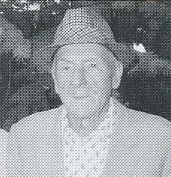
Leslie Hunt was sent to Canada by the Liverpool Sheltering Home in 1920, aged only 10 years. He has always thought of himself as a Barnardo's boy though, because in 1925, Barnardo's took over the role of supporting him when the LSH organisation closed down.
Leslie travelled many miles from his home in Toronto to meet Kate (After Care working visiting Canada from Barnardo's in England) at his son's house. With his grand daughter Kimberley, who is working on the history of the family, he related fascinating stories of his many and varied life experiences, including his distinguished service in the Second World War.
Bother Thomas (Spencer - father of Ivy Sucee) and Leslie spoke of their regrets at not receiving a better education but neither of them has allowed that to hold them back. Indeed Leslie resolved many years ago that he would learn a new fact every day and keeps to this even now with only occasional lapses!
-from the 2002 Barnardo's Guild Magazine
Leslie travelled many miles from his home in Toronto to meet Kate (After Care working visiting Canada from Barnardo's in England) at his son's house. With his grand daughter Kimberley, who is working on the history of the family, he related fascinating stories of his many and varied life experiences, including his distinguished service in the Second World War.
Bother Thomas (Spencer - father of Ivy Sucee) and Leslie spoke of their regrets at not receiving a better education but neither of them has allowed that to hold them back. Indeed Leslie resolved many years ago that he would learn a new fact every day and keeps to this even now with only occasional lapses!
-from the 2002 Barnardo's Guild Magazine
Ada F Hollis
|
Published in the Toronto Daily Star Saturday September 8 1906 Ada was the daughter of William Hollis and Jean Pendecrast. She arrived in Canada October 6 1902 brought by the Dr. Barnardo Homes. Ada married married Constant R Olivean in Toronto, York, Ontario on 10 October 1911. Immigration Record Surname:HOLLIS Given Name:Ada F. Age:14Sex:F Ship:Colonian Year of Arrival:1902 Departure Port:Liverpoo Departure Date:1902-09-25 Arrival Port:Portland Arrival Date:1902-10-06 Party:Barnardo Homes Destination:Peterborough, Ontario Comments:A party of 125 girls, this record found on film #C-4715 at the Library and Archives Canada Source:Library and Archives Canada Reference:RG 76, Vol. 51, File 2209, part 1, Documents from Immigration Branch, Central Registry Files Type of Record:Other Government of Canada records |
Bertha Joy
|
Bertha arrived in Canada on October 2 1903 brought by the Dr. Barnardo Homes. She was taken to the Hazel Brae Barnardo Home in Peterborough, Ontario. Her name is inscribed on the Hazel Brae Barnardo Home Memorial there.
Noted is a copy of the Ups and Downs Magazine Bertha Joy,we think this is a very sweet little picture of Bertha, and are glad to hear that she is getting on well with Miss Maude Stanley of Colborne. |
On the 1911 Canadian Census Bertha is found (note: name is transcribed wrong as Bertha Jay) working as a servant for Bert and Lewis Math. Surname:JOY Given Name:Bertha Age:10 Sex:F Ship:Dominion Year of Arrival:1903 Departure Port:Liverpool Departure Date:1903-09-23 Arrival Port:Quebec Arrival Date:1903-10-02 Party:Barnardo Homes Destination:Peterborough, Ontario Source:Library and Archives CanadaReference:RG 76 C1aMicrofilm:T-482Type of Record:Passenger Lists |
Lizzie Farrell & Annie Ware
|
From the Ups and Downs Magazine
Lizzie Farrell and Annie Ware. This is a very interesting little group - the two girls, who were foster sisters, with Mrs. Manary's baby. Lizzie is still with Mrs. Edward Manary, of Bracebridge and is getting along very nicely, but Annie Ware, who is sitting down in the picture, has been transferred to Mrs. Geo. Thompson of Germania, and, we are glad to hear, is doing well. Annie Ware was brought to Canada by the Dr. Barnardo Homes in 1904. She arrived aboard the Southwark on October 9 1904. Annie was taken to the Hazel Brae Home in Peterborough. Her name appears on the Hazel Brae Barnardo Home Memorial erected in Peterborough, Ontario 2011.
|
Maud Brown
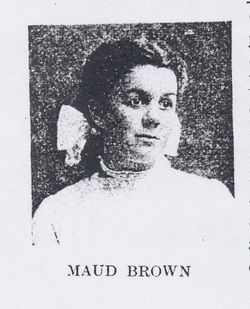
From the Ups and Downs Barnardo Magazine, May 1910
Maud Brown is much liked and is treated as a daughter by Mrs. Nathan Duxbury. She is an economical girl and has quite a nice little bank account. We hear that Maud is very fond of music and hopes to be able to purchase for herself a little American organ. We hope she will derive much pleasure and benefit from so doing.
On the 1911 Census for Canada, Maud is found living with the family of Nathan Duxbury and his wife Lucy Jane Duxbury. Maud gives her birth date as January 1894. They are living in the district of Grey North, Ontario. Maud had come to Canada in 1906 brought by the Dr. Barnardo Homes. She would be taken to the Hazel Brae Home in Peterborough, Ontario.
Maud was the daughter of George Brown and Sarah Willes. On June 3 1914 in Grey County, Ontario she married Henry F Lobben. He was born in Scotland and was the son of George Lobben and Jesse Walker.
Maud Brown is much liked and is treated as a daughter by Mrs. Nathan Duxbury. She is an economical girl and has quite a nice little bank account. We hear that Maud is very fond of music and hopes to be able to purchase for herself a little American organ. We hope she will derive much pleasure and benefit from so doing.
On the 1911 Census for Canada, Maud is found living with the family of Nathan Duxbury and his wife Lucy Jane Duxbury. Maud gives her birth date as January 1894. They are living in the district of Grey North, Ontario. Maud had come to Canada in 1906 brought by the Dr. Barnardo Homes. She would be taken to the Hazel Brae Home in Peterborough, Ontario.
Maud was the daughter of George Brown and Sarah Willes. On June 3 1914 in Grey County, Ontario she married Henry F Lobben. He was born in Scotland and was the son of George Lobben and Jesse Walker.
|
Maud's name as it appears on the Hazel Brae Barnardo Home Memorial in Peterborough, Ontario, Canada
|
Given Name:Maud
Age:12 Sex:F Ship:Friesland Year of Arrival:1906 Departure Port:Liverpool lDeparture Date:1906-04-18 Arrival Port:Philadelphia Arrival Date:1906-04-30 Party:Barnardo Homes Destination:Peterborough, Ontario Comments:Party of girls to Peterborough Source:Library and Archives Canada Reference:RG 76 C1fMicrofilm:T-513 Type of Record:Passenger Lists |
Earnest Robert Schacht (Sharpe)
|
Immigration Record Surname:SCHACHT Given Name:Ernest RobertAge:18 Sex:M Ship:Saxonia Year of Arrival:1921 Departure Port:London Departure Date:1921-04-09 Arrival Port:Halifax Arrival Date:1921-04-18 Destination:Various locations Comments: Labourers & Domestics Notes:The child's surname was illegible or difficult to decipher Source:Library and Archives Canada Reference:RG 76 C1bMicrofilm:T-14800Type of Record:Passenger Lists If you have any information on Earnest or are a relative please contact his Great Niece Stella Wilson at [email protected] Please note: all Ernest’s siblings here in Uk seem to having changed their name from the Germanic Schacht to Sharpe |
Douglas SmeltPhoto from Barnardo Guild Magazine 2002
no details of Douglas's life was given |
Surname:SMELTGiven Name:DouglasAge:13Sex:MShip:Duchess of BedfordYear of Arrival:1930Departure Port:LiverpoolDeparture Date:1930-09-19Arrival Port:QuebecArrival Date:1930-09-26Party:Barnardo HomesDestination:Mr. J. W. Hobday, 538 Jarvis Street, Toronto, OntarioNotes:Vol. 21, p. 204Source:Library and Archives CanadaReference:RG 76 C1aMicrofilm:T-14769Type of Record:Passenger Lists Oh his immigration record the next of kin given was Grandmother-Mrs A Smelt, 1 Spring Gardens, Hawthorn Avenue, Hessle Road, Hull |
Walter Camp
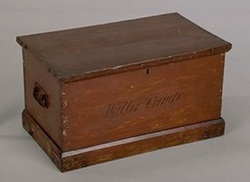
Walter Camp arrived in Canada
1887-03-28 aboard the
Parisian. He was brought here by the Dr. Barnardo Homes and was taken to Toronto. He was said to have been 10 years old at this time. Also aboard this ship was a Samuel Camp 13 years old (he went to Hazel Brae in Peterborough) and a Walker Camp, also 10 years old.
Surname:CAMP
Given Name:
Walter
Age:10
Sex:M
Ship:Parisian
Year of Arrival:1887
Departure Port:Liverpool
Departure Date:1887-03-17
Arrival Port:Halifax
Arrival Date:1887-03-28
Party:Barnardo Homes
Destination:Toronto, Ontario
Comments:209 boys, see also General Correspondence Files RG 17, Vol. 550, File 61591.5Source:Library and Archives CanadaReference:RG 76 C1bMicrofilm:C-4513Type of Record:Passenger Lists
Surname:CAMP
Given Name:
Walter
Age:10
Sex:M
Ship:Parisian
Year of Arrival:1887
Departure Port:Liverpool
Departure Date:1887-03-17
Arrival Port:Halifax
Arrival Date:1887-03-28
Party:Barnardo Homes
Destination:Toronto, Ontario
Comments:209 boys, see also General Correspondence Files RG 17, Vol. 550, File 61591.5Source:Library and Archives CanadaReference:RG 76 C1bMicrofilm:C-4513Type of Record:Passenger Lists
John Arthur Clark
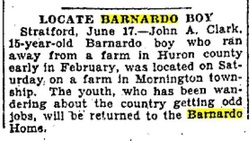
John ArthurAge:10Sex:MShip:MinnedosaYear of Arrival:1923Departure Port:SouthamptonDeparture Date:1923-09-13Arrival Port:QuebecArrival Date:1923-09-21Party:Barnardo HomesDestination:Toronto and Peterborough, OntarioComments:Third party of Barnardo children in 1923, 86 boys to Toronto and 48 girls to PeterboroughSource:Library and Archives CanadaReference:RG 76 B 1 aMicrofilm:C-4716Type of Record:Other Government of Canada records
On 21 September 1923, John Arthur Clark, 10, arrived in Canada, he was going to Mr J W Hobday, 538 Jarvis St, Toronto, Ontario, his next of kin was his father-William Clark, 18 Vera Road, Clydach on Tawe, nr Swansea, South Wales, he gave his birthplace as London.
On 21 September 1923, John Arthur Clark, 10, arrived in Canada, he was going to Mr J W Hobday, 538 Jarvis St, Toronto, Ontario, his next of kin was his father-William Clark, 18 Vera Road, Clydach on Tawe, nr Swansea, South Wales, he gave his birthplace as London.
Leslie James Alexander
|
and this could be the fellow with Smith with appendicitis: 1911 Census of Canada
Name:Thomas C Wicken Age:19 Birth Date:Mar 1891 England Relation to Head of House:Lodger Immigration Year:1905 District:Dufferin Orangeville, Wellington St James M Smith63 Elizabeth Smith56 Charles J Smith30 **Thomas C Wicken19 |
John (Leslie) CoombsThe Barnardo guild Messenger Summer 2002
John Coombs (known as Leslie Coombs) died on April 3 2002 aged 94 years. Leslie was migrated to Canada when he was 14 on the SS Montrose. He lived in the Bowmanville area all his life and had a mixed farm. He had five sons, one daughter and many grandchildren. |
Surname: COOMBS Given Name: J C L Age: 14 Sex: M Ship: Montrose Year of Arrival: 1922 Departure Port: Liverpool Departure Date: 1922-06-30 Arrival Port: Quebec Arrival Date: 1922-07-07 Party: Annie Macpherson Homes Destination: Belleville, Ontario Comments: Mixed party of 100 Source: Library and Archives Canada Reference: RG 76 Vol 64 File 3081 Part 3, Documents from Immigration Branch, Central Registry Files, See also Immigration Form 30A for Robina Basnett Microfilm: C-4732 Type of Record: Other Government of Canada records |
Joseph Bowles
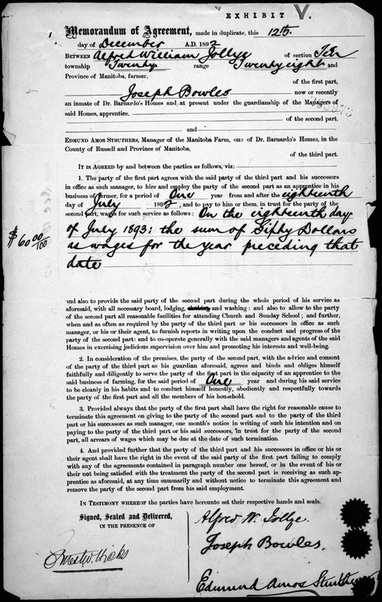
Document dated December 12 1892
Joseph Bowles was brought to Canada in 1890 by the Dr. Barnardo Homes in England. He departed on the Circassian on June 191890 from Liverpool and arrived in Quebec on June 30 1890. He was part of a pary of 141 children.
Comments on his immigration record:Sailed via Londonderry, 20th. Party of 141; 11 to Manitoba, 130 to Ontario. Charles WORTHINGTON age 13 left behind at Quebec to be returned - sore hand. J W HUTTLEWORTH, a male age 19 was taken to Jeffery Hale hospital.
On the 1891 Census for Manitoba, Joseph is found working for the family of Eustact and Christy Power as a domestic in Marquette, Manitoba, Canada The Power's had two children at this time, Ellie three years old and Catherine, one year old.
In 1892 Joseph was sent to work on the farm of Alfred William Jolly of Manitoba. His work term was to be a year, at the end of which his he was to have been paid $60.
In 1911 Joseph is found living on his own farm in Portage la Prairie, Manitoba, Canada. The census states he is single. There is a death record found for Joseph Bowles in the Manitoba Vita Statistics. He died on October 24, 1911. There is no spouse noted.
Joseph Bowles was brought to Canada in 1890 by the Dr. Barnardo Homes in England. He departed on the Circassian on June 191890 from Liverpool and arrived in Quebec on June 30 1890. He was part of a pary of 141 children.
Comments on his immigration record:Sailed via Londonderry, 20th. Party of 141; 11 to Manitoba, 130 to Ontario. Charles WORTHINGTON age 13 left behind at Quebec to be returned - sore hand. J W HUTTLEWORTH, a male age 19 was taken to Jeffery Hale hospital.
On the 1891 Census for Manitoba, Joseph is found working for the family of Eustact and Christy Power as a domestic in Marquette, Manitoba, Canada The Power's had two children at this time, Ellie three years old and Catherine, one year old.
In 1892 Joseph was sent to work on the farm of Alfred William Jolly of Manitoba. His work term was to be a year, at the end of which his he was to have been paid $60.
In 1911 Joseph is found living on his own farm in Portage la Prairie, Manitoba, Canada. The census states he is single. There is a death record found for Joseph Bowles in the Manitoba Vita Statistics. He died on October 24, 1911. There is no spouse noted.
Oliver Cox
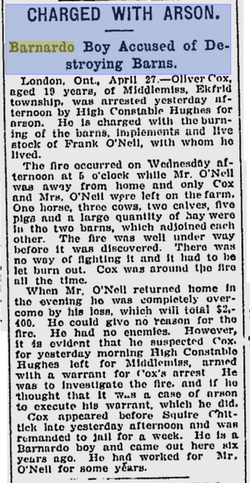
The Montrel Gazette
April 28, 1911
"CHARGED WITH ARSON
Barnardo Boy Accused of Destroying Barns
London, Ont., April 27.--Oliver Cox, aged 19 eyars, of Middlemiss, Ekfrid township, was arrested yesterday afternoon by High Constable Hughes for arson. He is charged with the burning of the barns, implements and livestock of Frank O'Neil with whom he lived.
The fire occurred on Wednesday afternoon at 5 o'clock while Mr. O'Neil was away from home and only Cox and Mrs. O'Neil were left on the farm. One horse, three cows, two calves, five pigs and a large quantity of hay were in the two barns, which adjoined each other. The fire was well under way before it was discovered. There was no way of fighting it and it had to be let burn out [sic]. Cox was around the fire all the time.
When Mr. O'Neil returned home in the evening he was completely overcome by his loss, which will total $2,400. He could give no reason for the fire. He had no enemies. However, it is evident that he suspected Cox, for yesterday morning High Constable Hughes left for Middlemiss, armed with a warrant for Cox's arrest. He was to investigate the fire and if he thought that it was a case of arson to execute his warrant, which he did.
Cox appeared before Squire Chittick late yesterday afternoon and was remanded to jail for a week. He is a Barnardo boy and came out here six years ago. He had worked for Mr. O'Neil for some years."
April 28, 1911
"CHARGED WITH ARSON
Barnardo Boy Accused of Destroying Barns
London, Ont., April 27.--Oliver Cox, aged 19 eyars, of Middlemiss, Ekfrid township, was arrested yesterday afternoon by High Constable Hughes for arson. He is charged with the burning of the barns, implements and livestock of Frank O'Neil with whom he lived.
The fire occurred on Wednesday afternoon at 5 o'clock while Mr. O'Neil was away from home and only Cox and Mrs. O'Neil were left on the farm. One horse, three cows, two calves, five pigs and a large quantity of hay were in the two barns, which adjoined each other. The fire was well under way before it was discovered. There was no way of fighting it and it had to be let burn out [sic]. Cox was around the fire all the time.
When Mr. O'Neil returned home in the evening he was completely overcome by his loss, which will total $2,400. He could give no reason for the fire. He had no enemies. However, it is evident that he suspected Cox, for yesterday morning High Constable Hughes left for Middlemiss, armed with a warrant for Cox's arrest. He was to investigate the fire and if he thought that it was a case of arson to execute his warrant, which he did.
Cox appeared before Squire Chittick late yesterday afternoon and was remanded to jail for a week. He is a Barnardo boy and came out here six years ago. He had worked for Mr. O'Neil for some years."
Joseph Edwards
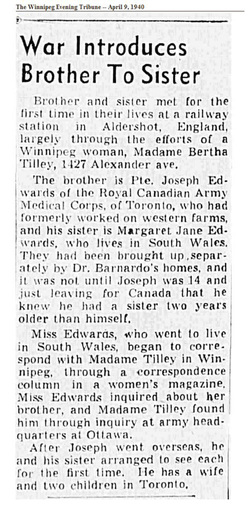
Joseph was brought to Canada aboard the Duchess of Canada in 1930. He was a ward of the Dr. Barnardo Homes.
Rose Kane
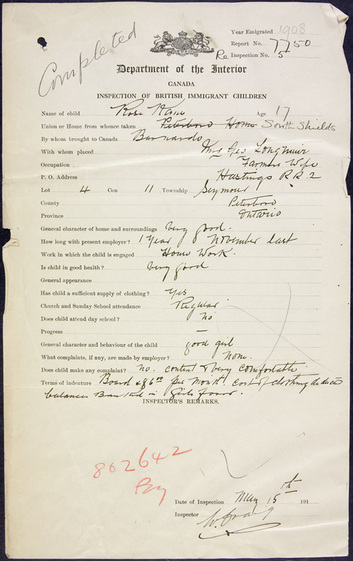
Credit Library and Archives Canada & British Home Children Descendants
In 1908, Rose Kane, 11, arrived at Quebec, Canada, along with a group of 109 girls en route to Peterborough, Ontario, Canada, and 219 boys en route to Toronto, Ontario, Canada, accompanied by Mr. Lloyd.
In 1911, Rose Kane, 14, was shown as a boarder in the home of Josiah and Sarah Cowan of 591 Bolivar, Peterboro, Ontario, Canada. Her date of birth is shown as May and her immigration year is not shown.
On May 5, c. 1914, an Inspection of British Immigrant Children was completed on Rose Kane (No. 7750). Information stated was that she had immigrated in 1908; that she was 17 years old; that she had originally been in the South Shields home; that she had been brought to Canada by Barnardos; that she was currently placed with Mr. and Mrs. George Longmuir, a farmer and his wife; that her current residence was Hastings RR2, Lot 4, Con 11, Seymour, Peterboro, Ontario, Canada. Her character was stated as being very good; that she had been with this placement for one year since November last; that she was engaged in housework; that she was in very good health; that she had a good supply of clothes; that she went to Sunday school and church regularly; that she did not attend day school; that she was a very good girl; that neither she nor her employer had any complaints; that she was content and very comfortable; and that the terms of her indenture were Board plus $86 per month / cost of clothing deducted / balance is banked in girl's favor.
On December 24, 1919, at Chatham, Essex, Ontario, Canada, a marriage was registered between Rose Elizabeth Kane, 21, housekeeper, born in England to unknown parents (George Cowan, guardian); and John Leonard Boycott, 21, machinist, born in Chester, England, to John R Boycott and Louisa Sophia Oakley.
In June 1923, Rose E. Boycott, 23, and her two children: John William Boycott, 2 months; and Margaret Boycott, 1, entered the United States through the Port of Detroit, Michigan. She declared that she had no occupation; that she would be returning to Canada; that they resided in Windsor, Ontario, Canada; that her next of kin was her father-in-law, John Boycott, who resided at 160 Cameron Avenue, Windsor, Ontario, Canada; that her husband paid her passage; that she would be staying in a room at 13935 Washburn Avenue, Detroit, Michigan; and that she was born in Essex, England.
In 1908, Rose Kane, 11, arrived at Quebec, Canada, along with a group of 109 girls en route to Peterborough, Ontario, Canada, and 219 boys en route to Toronto, Ontario, Canada, accompanied by Mr. Lloyd.
In 1911, Rose Kane, 14, was shown as a boarder in the home of Josiah and Sarah Cowan of 591 Bolivar, Peterboro, Ontario, Canada. Her date of birth is shown as May and her immigration year is not shown.
On May 5, c. 1914, an Inspection of British Immigrant Children was completed on Rose Kane (No. 7750). Information stated was that she had immigrated in 1908; that she was 17 years old; that she had originally been in the South Shields home; that she had been brought to Canada by Barnardos; that she was currently placed with Mr. and Mrs. George Longmuir, a farmer and his wife; that her current residence was Hastings RR2, Lot 4, Con 11, Seymour, Peterboro, Ontario, Canada. Her character was stated as being very good; that she had been with this placement for one year since November last; that she was engaged in housework; that she was in very good health; that she had a good supply of clothes; that she went to Sunday school and church regularly; that she did not attend day school; that she was a very good girl; that neither she nor her employer had any complaints; that she was content and very comfortable; and that the terms of her indenture were Board plus $86 per month / cost of clothing deducted / balance is banked in girl's favor.
On December 24, 1919, at Chatham, Essex, Ontario, Canada, a marriage was registered between Rose Elizabeth Kane, 21, housekeeper, born in England to unknown parents (George Cowan, guardian); and John Leonard Boycott, 21, machinist, born in Chester, England, to John R Boycott and Louisa Sophia Oakley.
In June 1923, Rose E. Boycott, 23, and her two children: John William Boycott, 2 months; and Margaret Boycott, 1, entered the United States through the Port of Detroit, Michigan. She declared that she had no occupation; that she would be returning to Canada; that they resided in Windsor, Ontario, Canada; that her next of kin was her father-in-law, John Boycott, who resided at 160 Cameron Avenue, Windsor, Ontario, Canada; that her husband paid her passage; that she would be staying in a room at 13935 Washburn Avenue, Detroit, Michigan; and that she was born in Essex, England.
John E Sanders
The [Toronto] Globe, Wednesday, November 14, 1894
A Sensation Exploded.
An Immigrant Boy Disappears in the County of Wellington, but is Found Safe and Sound at Hespeler.
Arthur, Nov. 12.–(Special.)–Considerable surprise and not a little curiosity was aroused in this vicinity a couple of days ago by the appearance in a local weekly of a paragraph to the effect that a young English lad from one of the immigration homes, who had been indentured to a farmer of Luther Township, had mysteriously disappeared some months ago, and that recently portions of a human body had been found in a rubbish heap on the farm burnt and charred beyond possibility of identification. The surprise was caused by the absence of any previous knowledge of the “horrible tragedy” in the district, and the curiosity was to discover how, when, where and by what means, so remarkable a yarn came to be manufactured out of the whole cloth. The matter would not, however, have excited interest for more than a few hours but for the fact that a day or two later a Toronto paper reproduced the paragraph as a “special” from Guelph; and this being brought to the attention of Crown-Attorney Peterson, he caused some inquiry to be made, which quickly set the affair at rest. Your correspondent also took a hand in the investigation, and, as so much publicity has already been given to the story, the facts as briefly given below will be of interest.
About a year and a half ago Mr Thomas Waters, a farmer in comfortable circumstances, owning and working a 200-acre farm on the seventh concession of Luther, on the confines of the little hamlet of Damascus, about eight miles northeast from this town, procured a twelve-year-old lad named John E. Sanders from the Barnardo Home in Toronto. Mr Waters had previously had a boy from the same institution, but he ran away after being there a short time, and the management of the home were so throughly satisfied that the runaway had not been improperly treated that they sent young Sanders to take his place, without further expense to Mr Waters. According to Mr Waters’ own statement Sanders got along all right for a time, until about three or four months ago, when he seemed to get lazy and indifferent to his work, and finally, early in August, a serious misunderstanding arose between them over some ploughing, which the farmer claims to believe the boy was wilfully careless over, and the result was that Waters struck him a couple of times over the shoulder with the butt end of a whip he was carrying. Mr Waters declares that this was the first and only time he had laid a hand upon the lad, but it so angered Sanders that the next day he ran away to a neighbor’s, and only went back upon compulsion. The farmer, however, decided he would have nothing more to do with him and wrote to the home to that effect, and on August 24 he was returned to Toronto, under instruction from the superintendent.
To catch the train young Sanders had to leave Damascus very early in the morning, before most of the good people were up, and as no one saw him leave his subsequent non-appearance started the gossips, and in a short time the weird and blood-curdling narrative mentioned above was flying about the country. Thomas Bishop, the local constable, heard the rumors about a week after the boy left, and at once did the most sensible thing possible under the circumstances, vis., wrote to the home to inquire and in a few days got a reply to the effect that everything was all right. This he quickly made known among the neighbors, but the first story had got too good a start, and, though it was discredited in the immediate vicinity, and would long ere this have been forgotten. It continued to travel abroad, until, as stated above, it struck a Toronto newspaper office.
So much for the “disappearance,” but the story of the “burnt and charred remains” is not traceable to this source, and, inasmuch as there has not been a burnt heap of any description on the Waters farm this fall, it must be concluded that there was not for this picturesque addendum even the slight foundation that the rest of the story had.
A Sensation Exploded.
An Immigrant Boy Disappears in the County of Wellington, but is Found Safe and Sound at Hespeler.
Arthur, Nov. 12.–(Special.)–Considerable surprise and not a little curiosity was aroused in this vicinity a couple of days ago by the appearance in a local weekly of a paragraph to the effect that a young English lad from one of the immigration homes, who had been indentured to a farmer of Luther Township, had mysteriously disappeared some months ago, and that recently portions of a human body had been found in a rubbish heap on the farm burnt and charred beyond possibility of identification. The surprise was caused by the absence of any previous knowledge of the “horrible tragedy” in the district, and the curiosity was to discover how, when, where and by what means, so remarkable a yarn came to be manufactured out of the whole cloth. The matter would not, however, have excited interest for more than a few hours but for the fact that a day or two later a Toronto paper reproduced the paragraph as a “special” from Guelph; and this being brought to the attention of Crown-Attorney Peterson, he caused some inquiry to be made, which quickly set the affair at rest. Your correspondent also took a hand in the investigation, and, as so much publicity has already been given to the story, the facts as briefly given below will be of interest.
About a year and a half ago Mr Thomas Waters, a farmer in comfortable circumstances, owning and working a 200-acre farm on the seventh concession of Luther, on the confines of the little hamlet of Damascus, about eight miles northeast from this town, procured a twelve-year-old lad named John E. Sanders from the Barnardo Home in Toronto. Mr Waters had previously had a boy from the same institution, but he ran away after being there a short time, and the management of the home were so throughly satisfied that the runaway had not been improperly treated that they sent young Sanders to take his place, without further expense to Mr Waters. According to Mr Waters’ own statement Sanders got along all right for a time, until about three or four months ago, when he seemed to get lazy and indifferent to his work, and finally, early in August, a serious misunderstanding arose between them over some ploughing, which the farmer claims to believe the boy was wilfully careless over, and the result was that Waters struck him a couple of times over the shoulder with the butt end of a whip he was carrying. Mr Waters declares that this was the first and only time he had laid a hand upon the lad, but it so angered Sanders that the next day he ran away to a neighbor’s, and only went back upon compulsion. The farmer, however, decided he would have nothing more to do with him and wrote to the home to that effect, and on August 24 he was returned to Toronto, under instruction from the superintendent.
To catch the train young Sanders had to leave Damascus very early in the morning, before most of the good people were up, and as no one saw him leave his subsequent non-appearance started the gossips, and in a short time the weird and blood-curdling narrative mentioned above was flying about the country. Thomas Bishop, the local constable, heard the rumors about a week after the boy left, and at once did the most sensible thing possible under the circumstances, vis., wrote to the home to inquire and in a few days got a reply to the effect that everything was all right. This he quickly made known among the neighbors, but the first story had got too good a start, and, though it was discredited in the immediate vicinity, and would long ere this have been forgotten. It continued to travel abroad, until, as stated above, it struck a Toronto newspaper office.
So much for the “disappearance,” but the story of the “burnt and charred remains” is not traceable to this source, and, inasmuch as there has not been a burnt heap of any description on the Waters farm this fall, it must be concluded that there was not for this picturesque addendum even the slight foundation that the rest of the story had.
Jennie Smith
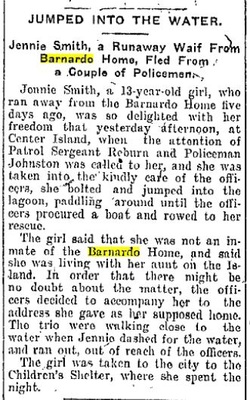
The Toronto Daily Star, Friday September 5 1902
Henry Modack

The Toronto Daily Star Saturday February 16 1901
Winnifred Payne
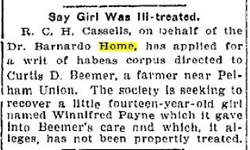
Tuesday, Sep 11, 1906 The Toronto Daily Star
Samuel Wardell

The Toronto Star
Saturday Jan 17, 1899
Saturday Jan 17, 1899
The Daily Telegraph in Saint John, New Brunswick
Aug. 29, 1887
In the Daily Telegraph in Saint John on Aug. 29, 1887 an article published about yet -another group of home children notes that 17 girls, ages of 10 and 20 had all been successfully “placed” in Albert and Kings counties, New Brunswick. “Seventeen Scotch girls whose ages range between 10 and 20 years were at the Bangor House yesterday. With the exception of five, they all came from Maryhill school near Glasgow where they have been trained as general domestics and educated to the fifth standard. Last eve they attended service in St. David’s Church, Saint John.” Further in the article it states: “Mrs. McKenzie of Nerepis was in town yesterday and took a little girl 10 years of age home with her last eve as an adopted daughter.”
The names given were: Maggie Wason, Maggie McCallum, Mary Logie, Mary B. Henderson, Minnie Logie, Mary Gillies, Katie Duffy, Robina Mitchell, Jessie Paul, Agnes Ross, Lizzie Mills, Agnes Stewart, Katie Reid, Maggie Gow, Agnes Francis and Jane Watson.
These girls arrived in Canada August 27 1887 aboard the Nova Scotian with Mrs. Cameron`s party. There was a group of 18 girls traveling together.
The names given were: Maggie Wason, Maggie McCallum, Mary Logie, Mary B. Henderson, Minnie Logie, Mary Gillies, Katie Duffy, Robina Mitchell, Jessie Paul, Agnes Ross, Lizzie Mills, Agnes Stewart, Katie Reid, Maggie Gow, Agnes Francis and Jane Watson.
These girls arrived in Canada August 27 1887 aboard the Nova Scotian with Mrs. Cameron`s party. There was a group of 18 girls traveling together.
Henry J McLaughlin
|
From LAC Home Children Database
Given Name(s):Henry Surname:McLAUGHLIN Age:13 Gender:M Ship:CARTHAGINIAN Port of Departure:Liverpool Date of Departure:1892-03-17 Port of Arrival:Halifax Date of Arrival:1892-03-27 Year of Arrival:1892 Party:Barnardo Homes Destination:Toronto, Ontario and Winnipeg, Manitoba Comments:303 children with Mr. Owen Type of Records:Passenger Lists Microfilm Reel Number:C-4515 Children travelling together:H92BA Source:Library and Archives Canada Reference:RG 76 C1b Item Number:35599 |
From Ancestry.ca
NAME:Henry McLaughlinAGE:6BIRTH DATE:16 Jan 1879SCHOOL:Bell Street SchoolBOROUGH:WestminsterADMISSION DATE:31 Aug 1885PARENT:Henry McLaughlinNOTES:Previously known as Bell Street Ragged School, Bell Street School (0223) from 1874. Renamed Bellfield Secondary School in 1951REFERENCE NUMBER:LCC/EO/DIV02/BELL/AD/006 |
